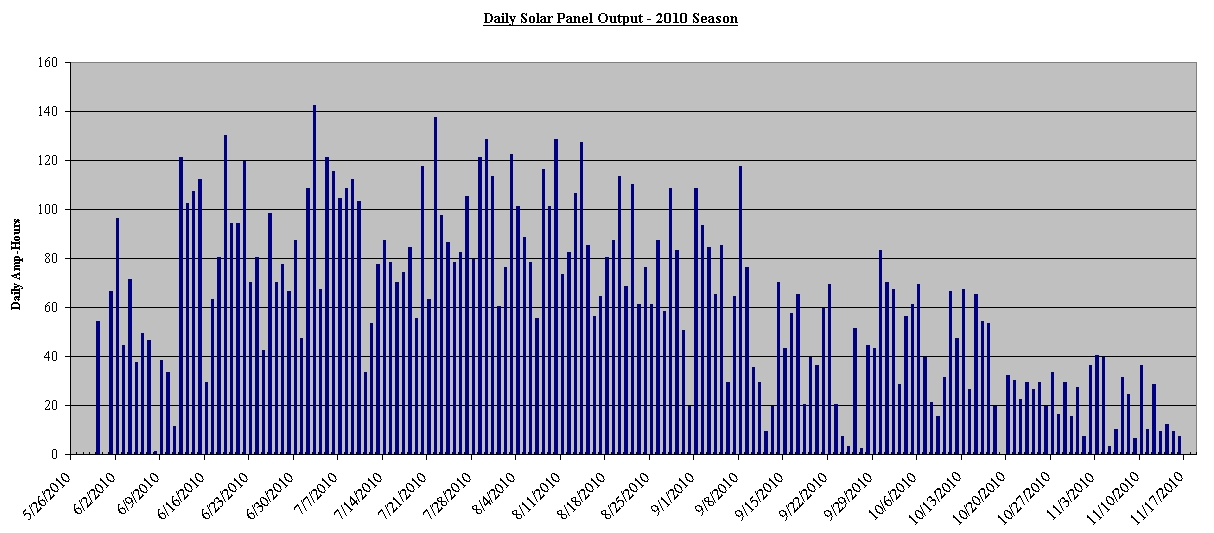Three years ago we added a solar panel array and have been tracking the benefits ever since. At the time, we only carried a single 32 watt panel (original to the boat and dating back to 1999) on top of our radar arch that put out a whopping 2 amps . . . if that. Basically, a trickler. Alongside our wind generator, which is quiet but equally as ineffective, we could hardly call ourselves self-sufficient.
Since the early 2000s, the price of solar panels has been decreasing while technology has been on the rise, along with fuel prices. So the timing was ideal for making a change. After (what seemed like) months of research, we purchased three Kyocera135 watt panels measuring 60 by 26 inches and weighing approximately 30 pounds. Needless to say, this required a bit of reconfiguring.
The dodger and bimini on Cambria are canvas and would have required substantial stainless work to accommodate the weight of the panels . . . one of which would have been shaded by the boom most of the day. In lower latitudes, shading wouldn’t make such a big impact but here where the sun is at a 30° angle in the height of summer and approximately 65° in the winter, it is. So we opted for the easier and (in our opinion) more practical installation and changed out two sections of lifelines (port and starboard) for a solid stainless bar which the panels are mounted on. When conditions are rough, they lie flat. But at other times of the day, we’re able to adjust them with props to maximize their output.
To control the system, we chose a Xantrex 60 amp MPPT with a battery temperature sensor. Not because it was our first choice or that our system required the capacity (it’s much bigger than we need and has the ability to add other panels later on). But the company manufacturing the one we had originally wanted (a Morningstar 45) was experiencing difficulties sourcing components from their Chinese suppliers. In the end, we were glad for the change and are very happy with the Xantrax’s performance.
Using the specifications provided by Kyocera, under optimal conditions the panels should generate 120 amp hours of power – 30 amps shy of our average daily consumption. But we generally see more than that. During the summer months, they produce 140 to 150 amps, with approximately 15 to 20 amps coming in during the peak hours (noon to four). On our best day, we banked 163 amp hours and on our worst day, none at all. But more important than the numbers, we’re not burning fossil fuels to compensate for our desire to watch movies or use the computer. And equally as important, David’s now a free man and is no longer held captive by the boat hour after hour in order to recharge the batteries – most days, the panels do all of the work.
We estimated that we’d recoup the cost of the system after three years, but our expectations were, once again, exceeded. By the middle of last season, the savings on fuel surpassed the price tag and we’ve been living free (give or take) since then. One of the greatest expenses to recover was the MPPT, with the materials for mounting coming in a close second. The panels themselves were the least expensive components, costing about $330 a piece.
David has a meticulous personality and has been tracking their performance for the past three years: Over the period, they’ve produced a total of 35,815 amp hours (482 kWh). To date, we estimate that we’ve saved over 900 hours of engine/generator use and approximately 850 gallons of fuel – a monetary savings of $4000. An excellent investment . . . for the boat as well as the environment.
* Looking at the three graphs, you can clearly point out the days when it rained . . . particularly late in the season. The mid-range days were generally ones in which we were moving.
* David keeps threatening to write a blog about the installation and design of our system but has yet to follow through. If that is something you'd be interested in, please contact us directly or in the comment section below to help persuade him.














0 comments